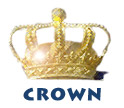|


The Aramaic word tagin,
meaning crowns, refers to the decorative crown-like flourishes added by
a scribe on the upper left-hand corner of certain letters in Torah scrolls.
A tag is generally composed of three flourishes or strokes, each
of which resembles a small "zayin" - thick on top with
a thin line extending downward to the letter. The center stroke is slightly
higher than the two end ones. The letters which receive the tagin
are ,
including ,
including  (final nun and tzadi).[1]
(final nun and tzadi).[1]

According to Maimonides
the omission of tagin does not invalidate the scroll since its
inclusion is considered as an "exceptionally beautiful fulfillment
of the mizvah."[2]
Ashkenazi custom, however, holds that the scrolls are invalid without
the appropriate tagin.[3]
Tagin are added to the letters on mezuzah and tefillin
(phylacteries) scrolls as well, but not in printed texts of the Bible.

Legend
ascribes the origin of the tagin to Sinaitic revelation. The
Talmud vividly describes Moses ascending on high to find God engaged
in affixing tagin to the letters of the Torah.

"When Moses went up
to God, he found God sitting and putting little crowns on the top of the letters
of the Law. He said to God, 'Who is it that forces You to put crowns to the
letters of the Law [which You have already written]? He replied, 'A man is to
appear on earth after many generations, Akiba b. Joseph by name, who will expound
for each top of every letter of the Law heaps and heaps of rulings'...."[4]

The book of Joshua
describes how Joshua set up twelve stones in the Jordan River and later
transferred them to Gilgal.[5]
According to tradition, these stones were inscribed not only with the
books of Moses but also held the proper usage of the tagin. A
medieval work called Sefer Tagin, written by the student of Rashi,
Simhah ben Shmuel of Vitry (d.1105) in his encyclopaediac work Mahzor
Vitry, sets out the rules for their correct application.

Talmudic, midrashic and
kabbalistic sources place great stress on the mystical meanings of the tagin.
Together with the letters and words of the Torah, every additional stroke
or sign is interpreted as a symbol revealing extraordinary secrets of the
universe and creation.

|